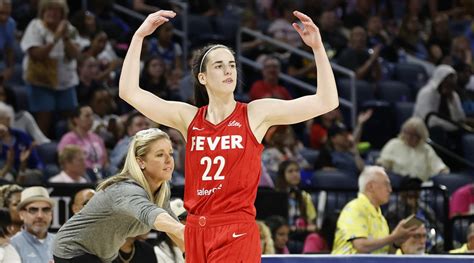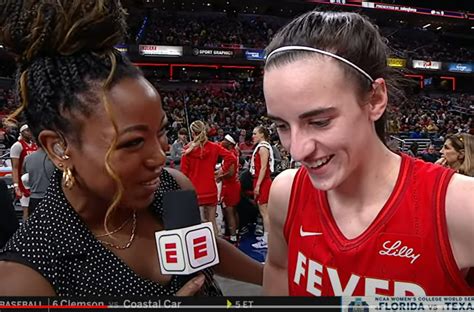
Caitlin Clark’s transition to the WNBA has ignited debates about whether the intense physicality and pressure are overwhelming the rookie sensation, prompting concerns about her long-term future in the league. The increased attention and aggressive play Clark faces have led some observers to question if the current environment is sustainable for her continued growth and enjoyment of the game.
The WNBA spotlight on Caitlin Clark has intensified, sparking a national conversation about the challenges she faces as a rookie. While her undeniable talent and record-breaking college career garnered unprecedented attention for women’s basketball, the transition to the professional level has been marked by heightened physicality, intense scrutiny, and questions about whether the league is adequately protecting its newest star. The debate centers on whether the pressure and on-court treatment are impacting Clark’s performance and potentially pushing her away from the WNBA.
Clark’s arrival in the WNBA with the Indiana Fever was met with unprecedented fanfare. The team’s games have drawn record crowds and television ratings, demonstrating her undeniable impact on the league’s popularity. However, the increased attention has also brought heightened expectations and a target on her back, with opposing players often displaying aggressive tactics against her.
“She’s handled it great. She’s a tough kid,” Fever coach Christie Sides said, acknowledging the challenges Clark faces. “She’s getting beat up. She’s learning. She’s learning the physicality of this league.”
The physicality Clark endures is a key concern. Multiple instances of hard fouls and aggressive defensive plays have raised questions about whether Clark is being unfairly targeted. Some argue that these tactics are simply part of the game, while others believe that the league needs to do more to protect its star player from unnecessary roughness.
The constant media attention and public scrutiny also add to the pressure on Clark. Every game, every shot, and every comment is analyzed and dissected, creating a relentless cycle of evaluation. This level of attention can be overwhelming for any player, especially a rookie adjusting to the professional ranks.
Furthermore, some analysts suggest that the current WNBA structure, including limited roster spots and player salaries, contributes to the intense competition and, consequently, the heightened physicality. Players are fighting for their livelihoods, and the pressure to perform is immense. This environment can create a sense of desperation, leading to more aggressive play.
Despite the challenges, Clark has shown resilience and determination. She continues to work hard and improve her game. Her teammates and coaches have also rallied around her, providing support and encouragement. However, the question remains whether the WNBA can create a more supportive and sustainable environment for Clark and other young stars to thrive.
The debate surrounding Clark’s experience highlights broader issues within the WNBA, including player safety, competitive balance, and the league’s responsibility to protect its star players. Addressing these issues will be crucial for ensuring the long-term health and growth of the league.
The pressure on Clark is undeniable. Her every move is scrutinized, and the expectations are incredibly high. While she has shown flashes of brilliance, she has also struggled at times, which is to be expected for a rookie. The question is whether she can continue to handle the pressure and thrive in the WNBA or if the challenges will ultimately prove too much.
The long-term implications of Clark’s experience are significant. If she is pushed away from the league, it could have a detrimental effect on the WNBA’s popularity and growth. Conversely, if she can overcome the challenges and succeed, it could inspire a new generation of players and fans.
Ultimately, the responsibility lies with the WNBA, the players, and the media to create a more supportive and sustainable environment for Clark and other young stars. This includes addressing issues of player safety, promoting fair play, and fostering a culture of respect. Only then can the league ensure that its brightest talents can thrive and reach their full potential.
The narrative surrounding Caitlin Clark’s early WNBA career has quickly shifted from celebratory to cautionary. The excitement that accompanied her arrival, fueled by her record-breaking college career and the subsequent surge in WNBA interest, has been tempered by concerns over the intense physical play she faces and the immense pressure placed upon her. These factors have led to speculation about whether Clark might be reconsidering her future in the league, raising questions about the sustainability of her current environment.
The core of the issue revolves around the perceived disparity between the treatment Clark receives on the court and the protection afforded to her by the league’s officiating. Critics argue that Clark is being subjected to excessively physical play, often disguised as aggressive defense, and that referees are not consistently calling fouls to deter such behavior. This sentiment is echoed by fans, analysts, and even some players who believe Clark is being unfairly targeted due to her high profile and the attention she brings to the WNBA.
Furthermore, the media frenzy surrounding Clark amplifies the pressure she faces. Every game, every performance, and every post-game comment is dissected and scrutinized, creating a relentless cycle of evaluation that can be mentally taxing. The constant spotlight makes it difficult for Clark to simply focus on her game and develop as a player. This intense scrutiny also extends to her personal life, with every aspect of her behavior and decisions subject to public commentary.
Adding to the complexity is the financial landscape of the WNBA. Limited roster spots and relatively low salaries compared to other professional sports leagues create a highly competitive environment where players are constantly fighting for their jobs. This pressure can manifest in more aggressive play and a win-at-all-costs mentality, potentially contributing to the physical challenges Clark faces.
Despite these challenges, Clark has demonstrated resilience and a strong work ethic. She continues to show flashes of brilliance and is committed to improving her game. Her teammates and coaches have also expressed support, emphasizing the importance of protecting and developing their star player. However, the underlying concerns about the league’s environment and its impact on Clark’s long-term future remain.
The situation raises broader questions about the WNBA’s responsibility to protect its star players, foster a culture of fair play, and ensure the long-term health and growth of the league. Addressing these issues will require a concerted effort from league officials, players, and the media to create a more supportive and sustainable environment for all athletes. The ultimate outcome will not only impact Clark’s career but also shape the future of the WNBA.
The article highlights the escalating narrative surrounding Caitlin Clark’s entry into the WNBA, focusing on the growing concerns that the league’s intense physicality and relentless media pressure might be overwhelming the rookie sensation. This has sparked a debate about whether the current environment is sustainable for her continued growth and enjoyment, with some observers questioning if it could potentially push her away from the league. The piece delves into the specifics of the challenges Clark faces, including aggressive on-court tactics, constant scrutiny, and the competitive dynamics within the WNBA.
The primary concern revolves around the perception that Clark is being subjected to excessively physical play without adequate protection from referees. This sentiment is supported by numerous instances of hard fouls and aggressive defensive plays that have raised questions about whether she is being unfairly targeted. Critics argue that her high profile and the attention she brings to the WNBA have made her a target for opposing players looking to make a statement.
The constant media attention and public scrutiny further exacerbate the pressure on Clark. Every game, every shot, and every comment is analyzed and dissected, creating a relentless cycle of evaluation that can be mentally taxing. This level of attention can be overwhelming for any player, especially a rookie adjusting to the professional ranks. The constant spotlight makes it difficult for Clark to simply focus on her game and develop as a player.
The financial realities of the WNBA also contribute to the intense competition and, consequently, the heightened physicality. Limited roster spots and relatively low salaries compared to other professional sports leagues create a highly competitive environment where players are constantly fighting for their jobs. This pressure can manifest in more aggressive play and a win-at-all-costs mentality, potentially contributing to the physical challenges Clark faces.
Despite these challenges, Clark has demonstrated resilience and a strong work ethic. She continues to show flashes of brilliance and is committed to improving her game. Her teammates and coaches have also expressed support, emphasizing the importance of protecting and developing their star player. They acknowledge the difficulties she faces but remain optimistic about her ability to overcome them.
The article also touches on the broader implications of Clark’s experience for the WNBA. Her arrival has brought unprecedented attention to the league, but the challenges she faces highlight the need for greater attention to player safety, fair play, and the overall health and growth of the league. Addressing these issues will require a concerted effort from league officials, players, and the media to create a more supportive and sustainable environment for all athletes. The ultimate outcome will not only impact Clark’s career but also shape the future of the WNBA. The league must find a way to balance the competitive intensity with the need to protect its star players and ensure a positive and sustainable environment for all.
The future of Caitlin Clark in the WNBA is a topic of increasing speculation, fueled by concerns about the physicality she endures and the relentless pressure she faces. The heightened scrutiny began the moment she entered the league, bringing unprecedented attention and viewership, but it has also exposed her to aggressive play and intense media coverage. This has prompted questions about whether the current environment is sustainable and conducive to her growth and enjoyment of the game.
The debate centers on the perception that Clark is being unfairly targeted on the court. Opposing players often employ aggressive defensive tactics, resulting in hard fouls and physical confrontations. Critics argue that referees are not consistently calling these fouls, leaving Clark vulnerable and unprotected. This lack of protection has led to concerns about her safety and the potential for injury.
Beyond the physical challenges, Clark also faces immense pressure from the media and the public. Every game, every shot, and every comment is analyzed and scrutinized, creating a relentless cycle of evaluation. This constant attention can be mentally taxing and overwhelming, making it difficult for her to focus on her game and develop as a player. The pressure to perform at a high level every night is immense, and any perceived failure is met with criticism and scrutiny.
The financial structure of the WNBA also contributes to the competitive intensity that Clark faces. Limited roster spots and relatively low salaries compared to other professional sports leagues create a highly competitive environment where players are constantly fighting for their jobs. This pressure can manifest in more aggressive play and a win-at-all-costs mentality, potentially exacerbating the physical challenges Clark faces.
Despite these challenges, Clark has demonstrated resilience and a strong work ethic. She continues to show flashes of brilliance and is committed to improving her game. Her teammates and coaches have also expressed support, emphasizing the importance of protecting and developing their star player. They acknowledge the difficulties she faces but remain optimistic about her ability to overcome them.
However, the underlying concerns about the league’s environment and its impact on Clark’s long-term future remain. The WNBA has a responsibility to protect its star players and ensure a fair and safe playing environment. This includes stricter enforcement of rules against excessive physicality and a greater emphasis on player safety. It also requires a more supportive and understanding media environment that recognizes the challenges faced by young players adjusting to the professional ranks.
The future of the WNBA depends, in part, on its ability to attract and retain talented players like Caitlin Clark. If the league fails to address the concerns about player safety and the overall environment, it risks alienating its stars and undermining its long-term growth potential. Creating a more sustainable and supportive environment for all players is essential for the continued success of the WNBA.
The questions surrounding Caitlin Clark’s WNBA experience highlight broader issues within the league. The intense physicality, relentless media scrutiny, and competitive pressures are not unique to Clark, but her high profile has brought these issues to the forefront. The WNBA must address these concerns to ensure a positive and sustainable environment for all players.
The debate about whether Caitlin Clark is being pushed away from the WNBA underscores the challenges faced by young stars entering professional sports. The transition from college to the pros is always difficult, but in Clark’s case, it has been magnified by unprecedented attention and scrutiny. The league must find a way to support its young stars and create an environment where they can thrive.
The long-term success of the WNBA depends on its ability to balance competitive intensity with player safety and well-being. The league must prioritize the health and safety of its players, enforce rules against excessive physicality, and create a more supportive and understanding environment. Only then can it ensure that its brightest talents can reach their full potential and contribute to the continued growth of the league.
The situation surrounding Caitlin Clark serves as a wake-up call for the WNBA. The league must take proactive steps to address the concerns about player safety, fair play, and the overall environment. This includes stricter enforcement of rules, greater emphasis on player development, and a more supportive media environment. By addressing these issues, the WNBA can create a more sustainable and positive environment for all players and ensure its long-term success.
The narrative surrounding Caitlin Clark’s early WNBA career is dominated by questions about the sustainability of her current environment. The intense physicality she faces on the court, coupled with the relentless media pressure, has sparked concerns that she might be reconsidering her future in the league. While Clark has shown resilience and a strong work ethic, the underlying challenges remain.
The primary concern revolves around the perception that Clark is being unfairly targeted by opposing players. This is evidenced by numerous instances of hard fouls and aggressive defensive plays that have raised questions about whether referees are adequately protecting her. Critics argue that her high profile and the attention she brings to the WNBA have made her a target for those looking to make a statement.
The constant media attention and public scrutiny further exacerbate the pressure on Clark. Every game, every shot, and every comment is analyzed and dissected, creating a relentless cycle of evaluation that can be mentally taxing. This level of attention can be overwhelming for any player, especially a rookie adjusting to the professional ranks.
The financial realities of the WNBA also contribute to the competitive intensity that Clark faces. Limited roster spots and relatively low salaries compared to other professional sports leagues create a highly competitive environment where players are constantly fighting for their jobs. This pressure can manifest in more aggressive play and a win-at-all-costs mentality, potentially contributing to the physical challenges Clark faces.
Despite these challenges, Clark has demonstrated resilience and a strong work ethic. She continues to show flashes of brilliance and is committed to improving her game. Her teammates and coaches have also expressed support, emphasizing the importance of protecting and developing their star player.
The future of Caitlin Clark in the WNBA is uncertain. While she has the talent and determination to succeed, the challenges she faces are significant. The league must address the concerns about player safety, fair play, and the overall environment to ensure that she and other young stars can thrive.
The WNBA has a responsibility to protect its star players and create a safe and supportive environment for all athletes. This includes stricter enforcement of rules against excessive physicality, greater emphasis on player development, and a more understanding media environment. By addressing these issues, the WNBA can ensure its long-term success and continue to attract and retain the best talent in the world.
Frequently Asked Questions (FAQ)
Q1: What are the main concerns being raised about Caitlin Clark’s experience in the WNBA?
A1: The main concerns revolve around the intense physicality she faces on the court, the perception that she is being unfairly targeted by opposing players, the relentless media pressure, and the overall competitive environment within the WNBA. Critics argue that referees are not consistently calling fouls against excessively physical play, leaving Clark vulnerable and unprotected. Additionally, the constant media scrutiny and the financial pressures of the league contribute to a challenging environment for a rookie.
Q2: Is there evidence to suggest that Caitlin Clark is being unfairly targeted on the court?
A2: There are numerous instances of hard fouls and aggressive defensive plays that have raised questions about whether Clark is being unfairly targeted. Analysts and fans have pointed to specific plays where Clark appears to have been subjected to excessive physical contact without corresponding fouls being called. The perception is that her high profile and the attention she brings to the WNBA have made her a target for opposing players looking to make a statement.
Q3: How is the media contributing to the pressure on Caitlin Clark?
A3: The media’s constant attention and public scrutiny are exacerbating the pressure on Clark. Every game, every shot, and every comment is analyzed and dissected, creating a relentless cycle of evaluation that can be mentally taxing. This level of attention can be overwhelming for any player, especially a rookie adjusting to the professional ranks. The constant spotlight makes it difficult for Clark to simply focus on her game and develop as a player.
Q4: What role does the WNBA’s financial structure play in the challenges Caitlin Clark faces?
A4: The financial realities of the WNBA contribute to the intense competition and, consequently, the heightened physicality. Limited roster spots and relatively low salaries compared to other professional sports leagues create a highly competitive environment where players are constantly fighting for their jobs. This pressure can manifest in more aggressive play and a win-at-all-costs mentality, potentially contributing to the physical challenges Clark faces.
Q5: What can the WNBA do to address the concerns about Caitlin Clark’s experience and ensure a more positive environment for all players?
A5: The WNBA can take several steps to address the concerns about Caitlin Clark’s experience and create a more positive environment for all players. This includes stricter enforcement of rules against excessive physicality, greater emphasis on player safety, and a more supportive media environment. The league can also invest in player development programs and work to increase salaries and improve working conditions. By addressing these issues, the WNBA can ensure its long-term success and continue to attract and retain the best talent in the world.









